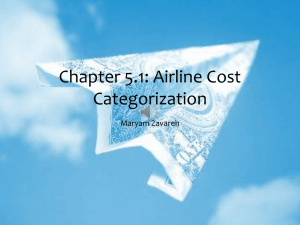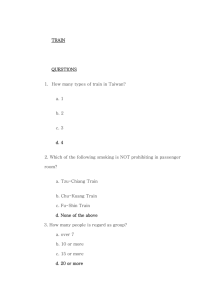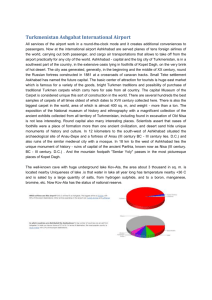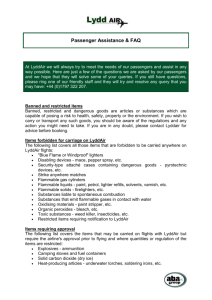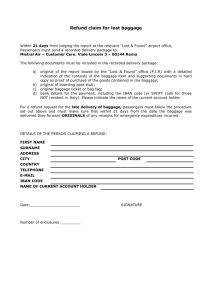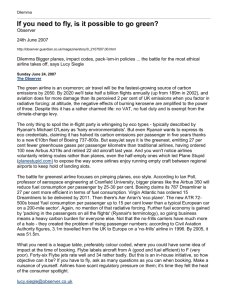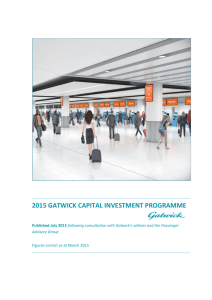Performance monitoring report for first half of 2015
advertisement
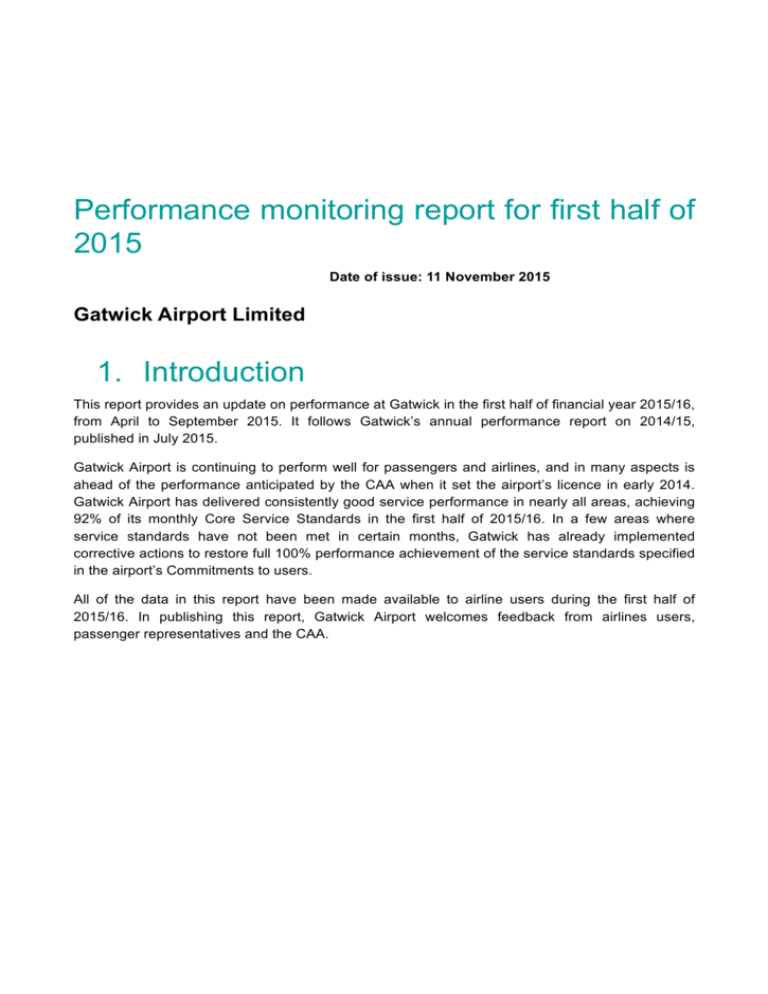
Performance monitoring report for first half of 2015 Date of issue: 11 November 2015 Gatwick Airport Limited 1. Introduction This report provides an update on performance at Gatwick in the first half of financial year 2015/16, from April to September 2015. It follows Gatwick’s annual performance report on 2014/15, published in July 2015. Gatwick Airport is continuing to perform well for passengers and airlines, and in many aspects is ahead of the performance anticipated by the CAA when it set the airport’s licence in early 2014. Gatwick Airport has delivered consistently good service performance in nearly all areas, achieving 92% of its monthly Core Service Standards in the first half of 2015/16. In a few areas where service standards have not been met in certain months, Gatwick has already implemented corrective actions to restore full 100% performance achievement of the service standards specified in the airport’s Commitments to users. All of the data in this report have been made available to airline users during the first half of 2015/16. In publishing this report, Gatwick Airport welcomes feedback from airlines users, passenger representatives and the CAA. 2. Traffic Gatwick Airport served 39.7 million passengers in the rolling 12 month period until September 2015. This was an increase of 5.7% over the same period in the previous year. In the six month period April-September 2015, Gatwick served 23.5 million passengers, an increase of 4.6% on the same period in 2014. The growth in passenger numbers was due to a combination of a higher number of Air Traffic Movements (ATMs), larger average aircraft size and higher load factors. Table 1: Traffic data 1h 2015/16 1h 2014/15 % change Passenger traffic (m) 23.528 22.484 4.60% ATMs (k) 148.877 144.686 2.90% Seats per ATM 181 180 0.52% Load factor (%) 87.2% 86.2% 1.0ppt Passengers per ATM 158.0 155.4 1.70% Figure 1: Change in traffic (pax) 24,000,000 23,500,000 119,505 23,000,000 273,098 651,281 22,500,000 22,000,000 23,528,059 21,500,000 21,000,000 22,484,175 20,500,000 20,000,000 2 European scheduled traffic now accounts for two thirds of Gatwick’s passenger traffic and continues to grow above the pace of total traffic (7.3% versus 5.7% for the moving annual total to the year ending September 2015). Gatwick’s fastest growing traffic segment is North Atlantic, which grew at 13.2% over the same period, and now makes up nearly 5% of total passenger traffic. Additional information on our traffic trends is also available in our monthly traffic updates1. 1 http://www.gatwickairport.com/business-community/about-gatwick/our-performance/monthly-traffic-figures/ 3 3. Service Quality This section provides an overview of service quality at Gatwick. It provides an overview of our performance against the Core Service Standards to which we have committed to build and operate the airport. It also provides an overview of other metrics important to our passengers, including baggage delivery and on time performance. Our published monthly reports contain a brief description of the service quality metrics2. Core Service Standards Under the Commitments framework, Gatwick has agreed targets across a range of service targets with our airline community. These Core Service Standards specify the services we are committed to delivering through the operations and facilities we provide to users. Where we fail to achieve the target in a given month, we issue a rebate on the airport charge to the airlines operating in the affected terminal. There are 21 Core Service Standards, 18 of which have individual measures for each terminal (the exceptions to this are the measures relating to the inter-terminal shuttle system, external control post security queuing and the airfield congestion term). In total, Gatwick’s performance is measured against 40 separate service targets for each month, giving 240 scores for a 6 month period. The sections below describe the performance across these measures, grouped into four categories: Quality of Service Metrics (QSM); security search; passenger operational metrics; and airfield operational metrics. Out of 240 total scores, 220 were passed, giving a pass rate of 92%. This remains a very good performance and by the end of the summer all metrics where passed. QSM metrics The QSM (Quality of Service Monitor) survey generates a set of passenger experience metrics. These are interview-based perception scores and capture how our passengers perceive Gatwick on a of 1 to 5 scale (where 5 is ‘Excellent’; 4 is ‘Good’; 3 is ‘Average’; 2 ‘Poor’ and 1 ‘Extremely Poor’), across four different categories: seating availability, cleanliness, wayfinding and flight information. The scores are calculated as moving annual totals (MATs). 2 Gatwick’smonthlyservicequalityreportscanbeaccessedhere:http://www.gatwickairport.com/businesscommunity/about-gatwick/our-performance/ 4 Table 2: QSM scores Target Departurelounge seatavailability Cleanliness Wayfinding Flightinformation Apr15 May15 Jun15 Jul15 Aug15 Sep15 North 3.80 4.01 4.00 4.03 4.03 4.05 4.08 South 3.80 4.05 4.05 4.05 4.08 4.07 4.05 North 4.00 3.99 3.99 4.00 4.00 4.00 4.01 South 4.00 4.15 4.15 4.15 4.16 4.16 4.15 North 4.10 4.15 4.14 4.13 4.13 4.12 4.12 South 4.10 4.21 4.21 4.21 4.22 4.22 4.22 North 4.20 4.32 4.33 4.34 4.35 4.36 4.37 South 4.20 4.39 4.39 4.39 4.38 4.39 4.39 As discussed in the previous report, the scores for cleanliness in North Terminal fell slightly below the target level from October 2014. The root cause of the low scores was driven in large part due to the reallocation of cleaning staff during the Summer 2014 Swissport crisis to address passenger complaints related to poor in bound baggage delivery. A separate contingent labour workforce is now in place to address ground handler performance issues related to in bound baggage delivery to passengers to ensure cleanliness performance is maintained. Changes to our construction protocols have also been made to improve passenger experience in areas where building works are underway. These changes include improvements to hoarding designs, project phasing, lighting, and wayfinding. The North Terminal cleanliness score has been achieved consistently since June 2015, this being achieved while extensive construction activity is ongoing in the North Terminal arrivals areas as part of our investment programme. Security Search The security metrics measure security queueing performance in 15 minutes segments across the day. The main targets are: • • • • Queues should be less than 5 minutes in more than 95% of 15 minute segments periods in a month in central passenger search; Queues should be less than 15 minutes in more than 98% of 15 minute segments in a month in central passenger search; There should not be any queues longer than 30 minutes in central passenger search; There are also targets for transfer passenger search, staff search and external control posts. 5 Table 3: Security search scores Target Central<5min Central<15min Central>30min Transfer<10min Staff<5min Controlposts<15min Apr15 May15 Jun15 Jul15 Aug15 Sep15 North 95.0% 96% 91% 93% 95% 92% 95% South 95.0% 95% 90% 91% 91% 95% 97% North 98.0% 99.6% 99.4% 99.2% 99.8% 99.4% 100.0% South 98.0% 99.8% 99.6% 99.8% 99.8% 99.8% 100.0% North 0 - - 1* - - - South 0 - - - - - - North 95.0% 99.7% 99.8% 99.5% 99.6% 99.9% 100.0% South 95.0% 99.5% 98.9% 96.9% 96.6% 99.2% North 95.0% 99.9% 99.9% 100.0% 99.9% 99.8% 100.0% South 95.0% 98.9% 98.6% 99.0% 99.0% 98.9% 95.0% 100.0% 100.0% 100.0% 100.0% 100.0% 100.0% *indicatesthenumberofdailyoccurancesinthemonthwhenthetargetwasnotmet. 98.5% 98.5% Overall security performance was good in the first half of 2015/16, and Gatwick is often seen as market-leading in driving efficiency and innovation in our security product. In 2015, we did however experience some issues relating to the implementation of our Generation II security product, which was introduced with the aim to deliver further efficiency improvements. The transition to the new security process and facilities in South Terminal caused service quality performance to drop temporarily. This was due to teething issues and strong traffic causing the demand for staff resource to be higher than we expected. This impacted both terminals as staff were shifted between the two to help equalise the experience between the terminals. Overall security performance however remained resilient, and despite being below standard passengers still queued for less than 7 min 30 seconds 95% of the time. We worked hard to restore performance and in September 2015 the Generation II facility in South Terminal Achieved its best ever performance against the target of over 97%. We also had a single occurrence, (in one single fifteen minute measurement period) of a queue longer than 30 minutes in North Terminal in June. This was due to combination of issues leading to a temporary staffing issue in NT on one day. All security targets were passed in both terminals in September and October. The lessons learned from the introduction of generation II in South Terminal will be applied when Generation II is introduced in North Terminal next year. Passenger operational metrics The passenger operational metrics are a range of measures targeting the availability of specific facilities services at the airport. These measures range from Passenger Sensitive Equipment (PSE) such as escalators and lifts, to the availability of the inter-terminal shuttle and the baggage system. 6 Table 4: Passenger operational scores Target Apr15 May15 Jun15 Jul15 Aug15 Sep15 PSE-Priority- monthly North 99.0% 99.9% 99.7% 99.8% 99.7% 99.7% 99.5% South 99.0% 99.7% 99.7% 99.7% 99.8% 99.7% 99.8% PSE-General- monthly North 99.0% 1.00 1.00 1.00 1.00 1.00 0.99 South 99.0% 1.00 1.00 1.00 1.00 1.00 1.00 One 99.0% 100.0% 100.0% 100.0% 100.0% 99.8% 100.0% Both 97.0% 99.8% 99.8% 99.8% 99.3% 99.3% 99.9% 0 1* 0 0 1* 0 0 0 0 0 0 0 0 0 Outboundbaggage- North 99.0% Monthly South 99.0% 100% 100% 100% 100% 100% 100% 99% 100% 100% 100% 100% 100% Arrivalsbaggagereclaim North 99.0% availability-monthly South 99.0% 100.0% 99.9% 100.0% 100.0% 100.0% 99.9% 100.0% 99.9% 99.9% 100.0% ts Search <= 15 min Shuttle-monthly Outboundbaggage- North Daily-97% South 99.9% 100.0% *indicatesthenumberofdailyoccurancesinthemonthwhenthetargetwasnotmet. Overall we achieved a very good performance across these measures, with only two single day failures of the daily outbound baggage target. Corrective actions have been implemented in response to each occurrence and we continue to invest in baggage systems as part of Stable Operations to continuously improve reliability and resilience. This is one of the new service standards introduced through the commitments framework. Airfield operational metrics The airfield operational metrics, like the passenger operational metrics, measure the availability for use of specific assets. 7 Table 5: Airfield operational scores Target Apr15 May15 Jun15 Jul15 Aug15 Sep15 Stands-monthly scores North 99.0% 90% 91% 90% 99% 100% 100% South 99.0% 100% 100% 100% 100% 100% 99% Jetties-monthly scores North 99.0% 88.9% 92.0% 89.9% 99.9% 99.9% 99.9% South 99.0% 99.9% 99.9% 99.8% 99.8% 99.7% 99.8% North 95.0% 0.97 96.6% 96.6% 96.5% 96.4% 96.6% South 95.0% 97.4% 97.0% 97.0% 96.8% 96.4% 96.5% Pierservice-MAT FEGP-monthly scores Congestionterm- monthlyscores North 99.0% 93.9% 94.0% 94.0% 100.0% 100.0% 100.0% South 99.0% 100.0% 100.0% 99.9% 100.0% 99.9% 99.5% - - - - - - 0 We met most of these targets. We did however unfortunately not manage to meet the Stands, Jetties and Fixed Electrical Ground Power (FEGP) targets for April, May and June. This was due to the construction work on pier 5 being delayed due to a shortage of electrical contractors in the construction sector. Once the stands on the pier became available for airline use in July, these scores returned to their normal levels. We have also modified the process we use with the airlines to manage exemptions relating to capital projects. Airline Service Standards Airline Service Standards are the performance metrics which we apply to our airline customers. These are targeted at areas we identified in our Commitments as being of key concern to our passengers, but which are not under our direct control. The two metrics we identified in our Commitments which are important for airlines to meet are inbound baggage delivery and check-in queuing. These two functions are both controlled by the airlines, and are with the delivery services performed by the airline’s nominated ground handling company. The metrics are designed to create an incentive for airlines to deliver a minimum level of service acceptable to passengers in these areas. If an airline fails to achieve the target in a given month, then a deduction is made from any Core Service Standard rebate they would otherwise have been entitled to in that month. If no rebate is owed (because Gatwick met all relevant service standards in that month), then the airline concerned is not subject to any financial penalty. Inbound Baggage Delivery The first airline service standards measure is inbound baggage delivery. The standard is divided into separate metrics for small/medium sized aircraft (such as a Boeing 737 or airbus A319) and large aircraft (such as Boeing 777, Airbus A380 or Boeing Dreamliners). The target is for the last bag off an aircraft to be delivered to the baggage carousel (for pickup by a passenger) within 35 8 minutes for small and medium sized aircraft and within 50 minutes for large aircraft. Gatwick Airport incentivises its airline users to achieve these targets for at least 95% of respective flights each month. The charts below highlight, for each aircraft size category, the monthly performance data for the airport as whole and for the highest and lowest performing of the leading airlines (i.e. top ten airlines by passenger volume). Figure 2: Baggage delivery performance Large sized aircraft - % of flights in less than 50 min Small/medium sized aircraft - % of flights in less than 35 min 100% 100% 90% 90% 80% 80% 70% 70% 60% Best worst 50% 60% Best worst 50% average average 40% target95% 40% 30% 30% 20% 20% 10% 10% target95% 0% 0% April May June July August September April May June July August September In preparation for the Summer 2015 season, Gatwick has worked closely with a number of airlines and their ground handlers to develop a better shared understanding of performance and has taken steps to help the ground handlers, for example by supporting their recruitment efforts, providing contingent labour, and introducing an incentive scheme for inbound baggage for the ground handlers. The campus wide results against this target is set out in the table below. Following on from an improving situation in the second half of 2014/15, baggage delivery performance has performed significantly better in the first half of 2015/16 than the same period last year. Gatwick plans to again make available the IBB incentive scheme for Summer 2016 to ensure the stabilisation of in-bound baggage performance. Table 5: Baggage delivery performance Target In-bound baggage Lastbag<55mins 97% Apr15 May15 Jun15 Jul15 Aug15 Sep15 96% 96% 96% 96% 96% 96% 99.2% 99.6% 99.4% 99.7% 99.2% 99.4% 9 Check in Queuing In our Commitments, we indicated that this metric would be introduced once a robust measurement system had been identified. This metric was not yet operational during 2014/15. A suitable system has however been trialled and is now being deployed in the check-in zones across the airport. Discussions are ongoing with the airlines to enable this as to be used to generate this performance metric. We expect to place the new queue measurement into service once the technology has been appropriately validated and we have consulted with airlines. The new queue measurement system will also enable us to offer services to both airlines and passengers. Real time information to airlines should enable better real time service delivery and improved resource scheduling. We may also be able to provide passengers with expected queue time information to help them better manage their travel as well as airline choice. Other performance indicator On time performance On time performance is not part of the core or airline service standards, however it is important to passengers, airlines and airports. This has been covered in a separate paper. On time performance is driven by a range of different factors, including: • • • • • Weather (such as high wind, snow, thunderstorms) Air space congestion and disruption Airline schedules Ground handling performance Ramp Congestion The chart below illustrates how performance varied across our top 10 airlines during the first half of 2015, showing average performance across Gatwick as a whole and the highest and lowest performance in each month among the leading airlines. It is important to note that at an airport of the size and complexity of Gatwick airline specific factors, such as ground handling performance, can have wider effects. For example, if an airline struggles to offload baggage from an aircraft on time, then this might have an impact not only on the affected aircraft, but also on the next aircraft due to use the affected stand. 10 Figure 3: on time performance among Gatwick’s top 10 airlines 100% 90% 80% 70% 60% max 50% min average 40% 30% 20% 10% 0% April May June July August September Gatwick is working with the airline community to help improve the on time performance of flights on our campus. This includes work to help the airlines be ready for the start of the day, increased use of collaborative working and innovative use of towing to support the operation. In the summer of 2015, Menzies Aviation (ground handler for easyJet) experienced difficulty in achieving planned staff levels and skills profile, which had a significant detrimental effect across all ramp operations, including aircraft turnarounds, on-time departure performance, and safety performance. During the summer a joint initiative was undertaken by Gatwick, easyJet and Menzies to improve on time departure performance. This work will continue during the winter to prepare for summer 2016. Another factor which affected on time performance during the summer of 2015 was European airspace congestion. During Summer 2016, the number of airspace restriction events doubled versus Summer 2015, including delays due to capacity restrictions resulting from combining air traffic control sectors in the Brest, Reims and Barcelona areas. In addition, several strikes of French air traffic controllers having had a negative impact to on time performance at Gatwick. Going forward, it will be increasingly important both for pan European work to be done to improve the reliability of European airspace as well as for airlines to appropriately include schedule resilience factors which reflect the actual levels of disruption experienced with airspace over Europe. 11
